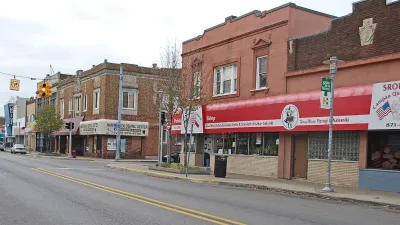More evidence of the public health benefits of walkable neighborhoods.

A new study published in the journal of Economics and Human Biology presents evidence of the immense health benefits of walkable communities for expectant mothers and their babies.
“Pregnant women that live in walkable communities—with more sidewalks, parks and walking paths—not only engage in more physical activity but are also more likely to experience favorable birth outcomes,” according to a press release from the University of New Hampshire announcing the study.
“They found that a 10-point increase in the walkability index—equivalent to transitioning from the "least walkable" to the "most walkable" category—is associated with a more than 70-minute increase in weekly exercise among pregnant women,” adds the press release. “This same change results in an 0.8 percentage point increase in the likelihood of a full-term birth, a 0.07-week extension in gestational age, a 27g increase in birth weight, and a 27% reduction in the likelihood of gestational diabetes and 16% reduction in hypertension.”
Researchers Karen Conway, professor of economics at UNH’s Peter T. Paul College of Business and Economics, and Andrea Menclova, associate professor of economics at the University of Canterbury used walkability measures created by the U.S. Environmental Protection Agency as well as detailed data on physical activity from the Behavioral Risk Factor Surveillance System and pregnancy outcomes from the National Vital Statistics Natality Detail Files to complete the study, according to the press release.
FULL STORY: Researchers Find Walkable Communities Are Healthier for Both Mom and Baby

Study: Maui’s Plan to Convert Vacation Rentals to Long-Term Housing Could Cause Nearly $1 Billion Economic Loss
The plan would reduce visitor accommodation by 25,% resulting in 1,900 jobs lost.

North Texas Transit Leaders Tout Benefits of TOD for Growing Region
At a summit focused on transit-oriented development, policymakers discussed how North Texas’ expanded light rail system can serve as a tool for economic growth.

Why Should We Subsidize Public Transportation?
Many public transit agencies face financial stress due to rising costs, declining fare revenue, and declining subsidies. Transit advocates must provide a strong business case for increasing public transit funding.

How to Make US Trains Faster
Changes to boarding platforms and a switch to electric trains could improve U.S. passenger rail service without the added cost of high-speed rail.

Columbia’s Revitalized ‘Loop’ Is a Hub for Local Entrepreneurs
A focus on small businesses is helping a commercial corridor in Columbia, Missouri thrive.

Invasive Insect Threatens Minnesota’s Ash Forests
The Emerald Ash Borer is a rapidly spreading invasive pest threatening Minnesota’s ash trees, and homeowners are encouraged to plant diverse replacement species, avoid moving ash firewood, and monitor for signs of infestation.
Urban Design for Planners 1: Software Tools
This six-course series explores essential urban design concepts using open source software and equips planners with the tools they need to participate fully in the urban design process.
Planning for Universal Design
Learn the tools for implementing Universal Design in planning regulations.
City of Santa Clarita
Ascent Environmental
Institute for Housing and Urban Development Studies (IHS)
City of Grandview
Harvard GSD Executive Education
Toledo-Lucas County Plan Commissions
Salt Lake City
NYU Wagner Graduate School of Public Service





























